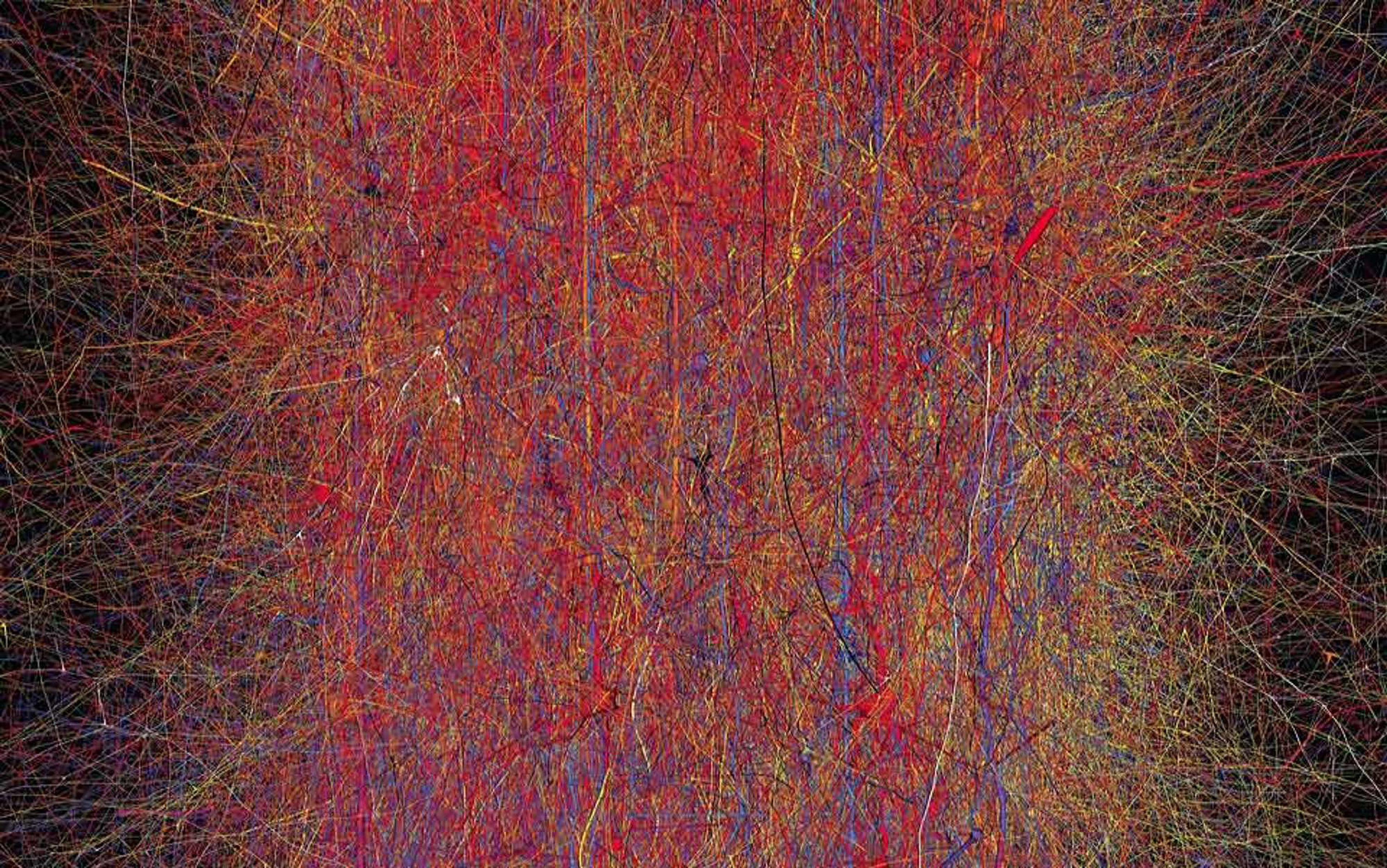‘The brain is a computer’ – this claim is as central to our scientific understanding of the mind as it is baffling to anyone who hears it. We are either told that this claim is just a metaphor or that it is in fact a precise, well-understood hypothesis. But it’s neither. We have clear reasons to think that it’s literally true that the brain is a computer, yet we don’t have any clear understanding of what this means. That’s a common story in science.
To get the obvious out of the way: your brain is not made up of silicon chips and transistors. It doesn’t have separable components that are analogous to your computer’s hard drive, random-access memory (RAM) and central processing unit (CPU). But none of these things are essential to something’s being a computer. In fact, we don’t know what is essential for the brain to be a computer. Still, it is almost certainly true that it is one.
I expect that most who have heard the claim ‘the brain is a computer’ assume it is a metaphor. The mind is a computer just as the world is an oyster, love is a battlefield, and this shit is bananas (which has a metaphor inside a metaphor). Typically, metaphors are literally false. The world isn’t – as a matter of hard, humourless, scientific fact – an oyster. We don’t value metaphors because they are true; we value them, roughly, because they provide very suggestive ways of looking at things. Metaphors bring certain things to your attention (bring them ‘to light’), they encourage certain associations (‘trains of thought’), and they can help coordinate and unify people (they are ‘rallying cries’). But it is nearly impossible to ever say in a complete and literally true way what it is that someone is trying to convey with a literally false metaphor. To what, exactly, is the metaphor supposed to turn our attention? What associations is the metaphor supposed to encourage? What are we all agreeing on when we all embrace a metaphor?
If it were a metaphor to say that the brain is a computer, then we would expect the claim to be literally false. This checks out with the point that our brains aren’t organised, like PCs, into silicon-based hard drives, RAMs and CPUs. We would also expect it to be difficult to flesh out exactly what we mean when we say that the brain is a computer. The value of the claim, were it a metaphor, would have to lie in whether it suggests the right things to attend to, whether it calls to mind fruitful associations, and whether it succeeds in bringing some coordination to the cognitive sciences. Some think that the supposed metaphor succeeds on these counts, while others think it fails and has poisoned the well of cognitive-science research.
But the claim that the brain is a computer is not just a metaphor. The cognitive sciences are full of hypotheses to the effect that the brain computes such-and-such in so-and-so a way. Many of our perceptual capacities, for example, are understood in computational terms, and there aren’t any viable alternatives around. Here are a handful of widely accepted hypotheses about what the brain computes, though I will leave out the details:
- Direction of sound from interaural time difference: if a loud crash occurs directly in front of you, its soundwaves will reach your left and right ears at the same time. If it occurs to your left, its soundwaves will reach your left ear slightly before they reach your right ear. When you hear a loud crash as being to your left or your right, your auditory system is computing, according to trigonometric principles, an estimate of that crash’s direction on the basis of the difference in times between when the sound waves arrived at your right and your left ears.
- Depth from disparity (or stereopsis): most things reflect light to both your eyes. Take one of your fingers and hold it arm’s length away from you, and take another finger and hold it halfway between the farther finger and your face. Now fix your gaze on the closer finger. Your farther finger will reflect light to a different part of your left eye (relative to its centre) than it will to your right eye (relative to its centre). To see this, keep fixating on your closer finger. Close one eye and pay attention to the space that’s visible between your nearer and farther finger. Now switch the eyes – open one and close the other. You’ll notice that the visible space between your fingers is different. If you now bring your farther finger a bit nearer to you and repeat the eye-closing experiment, the effect is less dramatic. When you see one thing as twice as far away as another, part of what is happening is that your visual system computes an estimate of depth by first computing which retinal cells are responding to the same point in the world, and then determining the relative difference (‘disparity’) in the positions or coordinates of those retinal cells (greater disparities = greater depth).
- Contour integration: when looking at the outline shape of an object in a cluttered scene, your visual system initially registers a bunch of tiny, individual segments of lines or contours (imagine lots of dashed lines). The visual system has to determine which line segments go with each other – which segments are parts of a common object’s outline, and which belong to different ones. The visual system computes outlines from line segments on the basis of, among other things, how close together those segments are, how similar in orientation they are, and whether they form an approximately straight line.
- Surface colour from illumination: the light that reaches your eye from a surface is a product of that surface’s colour and the colour of the illumination. So, your white shoes will reflect different types of light depending on whether it is daytime or dusk, or whether you are on the dance floor or in a fluorescent-lit bathroom. Still, you can usually tell that your shoes are white under these different conditions. When you see something as having a certain colour, your visual system is computing an estimate of the object’s colour by taking into account the nature of the illumination. The reason some people saw that dress as blue and black, and others saw it as white and gold, is that their visual systems are computing colours from different estimates of what the illumination is like.
Progress in cognitive science regularly consists in saying with mathematical precision exactly what is being computed – what direction should be estimated from some interaural time difference? – and exactly how the computation is performed. Hypotheses concerning these details can be and are tested against experimental observations, both of how people perform on tests (point to the loud noise, please) and of how populations of neurons respond to stimuli. There’s pretty stable agreement about what would count as evidence for or against hypotheses of this sort. Nobody has any real idea of how else to understand our abilities to, for example, perceive the locations of sounds or the depths, outlines and colours of objects.
Cognitive scientists seem to speak literally when they say that the brain computes
That’s a level of clarity and commitment to a premise that is uncharacteristic of metaphorical claims. Typically, if you press someone to explain just what type of oyster the world is, and where on Earth its gills are, everybody will agree that you’ve missed the point. But in cognitive science, hypothesising what specific kinds of computations the brain carries out and devising experiments to test these hypotheses is, far from missing the point, very often the job description.
Cognitive scientists seem to speak literally when they propose that the brain computes a certain function in a certain way. And the claim that the brain literally computes something implies that the brain is literally a computer (at least in part).
If it were just a metaphor to say that the brain is a computer, then we would expect it to be forever unclear what literal truths we are trying to convey with the use of this (presumably literally false) metaphor. But if the claim is meant literally, then we should hope for some precise account of what one is saying when one says that the brain computes. Some have dug in their heels, confident that cognitive scientists do know just what they are saying when they say that brains are computers: the claim is in fact a concrete, well-understood scientific hypothesis.
Unlike metaphors, whose value is independent of their literal falsity, scientific hypotheses are valuable insofar as they are (likely close to being) true and offer concrete, insightful explanations of phenomena. And, unlike metaphors, ideally one should be able to state precisely and with some completeness what a scientific hypothesis says about the world, and what experimental observations it predicts (give or take some background assumptions).
But the suggestion that we have on hand a precise and well-understood claim when we say that the brain is a computer feels forced. There really isn’t much clarity or agreement at all on what it means to say that the brain is a computer, even among those who agree that the claim is meant literally.
There is a whole mathematical field dedicated to understanding computation. Yet you might be surprised about how little clarity there is about what computation is. Foundational to the field is the Church-Turing thesis, named after the American philosopher-logician Alonzo Church (1903-95) and the English logician-mathematician Alan Turing (1912-54). Both Church and Turing were working to figure out what sorts of mathematical problems can and cannot be solved by blindly following rules of the sort you learn in order to do long division, long multiplication, or to solve quadratic formulas. In other words: what mathematical problems can be solved by rule-based calculation or, as it was called back then, computation? To answer this question, both Church and Turing developed, around the same time in the 1930s, mathematical models to capture what happens when one calculates the solution to a problem.
Church’s model of computation, the ‘lambda calculus’, emphasises giving explicit definitions of functions in terms of a small stock of very basic functions. To give a rough idea, the function 3 + (14 – x) can be defined as a sum, 3 + y, where y itself is defined as a subtraction, 14 – x. To determine what 3 + (14 – x) equals, when x = 6, one first solves for 14 – 6, and then adds that solution to 3, giving 11. The idea is to break up the problem into its smallest chunks, solving it chunk by chunk. Church proposed that a mathematical problem is computable just in case it can be expressed within his sparse language for defining functions in terms of more basic functions. For him, problemsolving involves giving an explicit definition of the problem, and then following that definition to its conclusion.
Turing’s model of computation emphasises rote rule-following. Remember how, when doing long division or solving for x, you would write one line and then, following a rule you were taught, you would write down another line underneath it that was based on the previous line, and so on until the last line you wrote gave the solution? Sometimes we felt entitled to skip a step or two, but the teacher would insist that you must ‘Show your work!’ Turing took this to the extreme. He defined a system of rules or constraints for writing one line based on a previous line, in which you could see all the work down to the last, minute detail, so that your teacher could not credibly ask you to show any more.
Suppose you start with a line of symbols expressing the problem to be solved:
… 21 x 3 = ? …
and you need to get to the final line expressing the solution:
… 63 …
Imagine you are writing everything down on graph paper, with no more than one item or symbol per square. You have an instruction manual telling you what to do at each step of the computation. You always start at a particular line, in a particular square on your notebook, and you handle only one square per step. Steps in the instruction manual say that, if the current square with which you are dealing contains such-and-such, then either erase that item from the square, leaving a blank spot in its place:
… 21 x 3 = [?] …
… 21 x 3 = [ ] … (where ‘[ ]’ indicates the square in the notebook with which you are dealing)
or enter so-and-so into the square (if it is blank):
… 21 x 3 = [ ] …
… 21 x 3 = [6] …
or move to an adjacent square:
… 21 x 3 = [6] …
… 21 x 3 = 6 [ ] …
Turing’s idea was that nobody who watches a solution get churned out in this way could reasonably ask for more work to be shown. These rules or constraints on how to solve a problem define what is called a ‘Turing machine’: a system that shows all its work. The term ‘Turing machine’ refers first and foremost to an abstract mathematical object or system, a set of constraints on how one line might be transformed into another, rather than to the physical devices that we build to embody these constraints. Turing proposed that a mathematical problem is computable just in case the expression of that problem can be transformed into an expression of its solution under these constraints.
Miraculously, the set of mathematical problems that can be defined and solved in Church’s language turns out to be exactly the same set of problems that can be solved by a Turing machine. Bolstered by this convergence, the Church-Turing thesis is that the set of problems that can be computed are just the set of problems that can be solved either by a Turing machine or that can be defined within Church’s calculus. In fact, there are many models besides Church’s and Turing’s, including certain types of artificial neural networks, that are capable of giving solutions to exactly the same set of problems.
Church-Turing tells us which problems are computable, but not what computation is
One of Turing’s great achievements was to show how a single ‘universal Turing Machine’ could be programmed to perform different computations. For any given problem, one can design a Turing machine with a custom-crafted instruction manual for solving that problem. Turing went a step further and showed how to make a Prime Mover of a machine, the instruction manual of which could guide you in performing any computation, so long as you tell it which one. This system performs a computation that computes other computations. This convenient innovation is the seed of the modern, multipurpose computers we have today, on which we install and uninstall all sorts of programs. But there’s no reason that a computer has to be programmable in this way. Some jobs (including, maybe, estimating the direction of a sound from interaural time differences) require computing the solution to only one kind of problem. Church, Turing and others provided an exciting variety of ways to get solutions to the same set of problems.
The Church-Turing thesis tells us which problems are computable, but not what computation is. Church and Turing offered different models for solving problems. They got the same solutions to the same problems but by different means. That means that you don’t have to be a Turing Machine to compute. You don’t have to write down line after line, step after step, in just the way that Turing describes. You could go to Church instead. You could turn to any of the other models of computation that give the same solutions to the same problems but in different ways. What makes these all models of computation? And how do we understand the possibility that two different models could both capture the same computation – long division, say?
Even if we focus on just one model of computation, there will be many different ways to get the same solution to a problem. But if a solution is reached through wildly different steps, then intuitively different computations have been carried out. This matters tremendously for cognitive science, which cares not just about saying what computable problem the brain might be solving but also about what specific kind of procedure or computation the brain performs in solving that problem. Different computations can take different amounts of time, do things in different orders according to different causal chains, and break down in different ways (therefore calling for different medical treatments when treatment is needed).
The Church-Turing thesis is just silent about deeply important features of computations. It says what set of problems can be computed and it says this by reference to two models of computation. But the thesis doesn’t say what it is about the different models of computation that makes them all models of computation. It doesn’t say what makes two problemsolving methods ‘the same’ computation or ‘different’ computations. So it says nothing about what a computation is. (Turing did try to give an account of computation, but it is debatable how successful it is. The American mathematician Richard Shore worried that addressing these issues might be pie in the sky.) Many roads lead to Rome. The Church-Turing thesis told us the location of Rome, but not what makes something a road.
We haven’t even touched the main sources of difficulty. The mathematical theory of computation is just that: mathematics. But the brain, like your PC, is a concrete thing. It’s a piece of nature. The stuff of mathematics doesn’t break down or decay. Numbers don’t chip at the edges; 1 + 2 will never take on a different value because moss started growing over the number 2 or because the operation of addition got jammed. Even if we had a precise, adequate and agreed-upon mathematical definition of what computation is (and we don’t), this wouldn’t tell us what it means for a part of the natural world – the sort of thing that can rust or sneeze – to perform a computation. One problem is to understand the nature of computation. Another is to understand the nature of computation in nature.
In fact, we often say that something in nature performs a particular computation even when that thing doesn’t always give out the answers that the computation, by definition, is supposed to give out. My laptop runs the latest version of my word processor even though it will sometimes stall on account of the 732 tabs that I have open on my web browser. A Lego set can compute addition even if some of the pieces get gunk in them, preventing them from moving as they should. Likewise, your brain can compute the direction from which a sound arises according to a particular trigonometric rule, even if it sometimes makes errors that are incompatible with that rule. We expect these errors in anyone, and we find greater errors among those of us who are hearing-impaired. But why think that most people’s auditory systems are solving the same trigonometric problems in error-prone ways rather than solving their own personally tailored problems in an error-free way?
It isn’t as arbitrary as it seems. The reasonable thing to say is that something performs a computation if it would normally perform that computation. Abnormal and non-ideal circumstances – having a head cold while walking through an organ-grinding festival – can lead to errors. This causes surprisingly few difficulties in cognitive science. Cognitive scientists are able to identify, in testable and motivated ways, which behaviours are the result of abnormal or interfering factors. But even though we have a stable, usable empirical concept of what computation a system ‘would normally perform’, it is wildly unsettled what it actually is for something to ‘normally perform’ one computation rather than another.
That’s just the beginning of our problems. In saying which problems could be solved by rule-bound calculations, Church and Turing defined models in which a set of symbols expressing the problem (the line ‘21 x 3 = ?’ in your notebook) is transformed into a set of symbols expressing the solution (‘63’). But the very same models could be used to convert meaningless gibberish (‘j&^@’) into other meaningless gibberish (‘•¡ø∂’). Would those transformations then count as computations? Turning back to the natural world: does it really matter that the firing of a neuron means that a sound came from thataway, or does it just matter that when this neuron here starts firing (whatever news or information that neuron might have about the world), it triggers those neurons over there to start firing?
If our brains are computers, our mental lives must be rich with meaningful information
In fact, the question of whether computation involves meaningful representation can bear on the question of what it is for a system to ‘normally perform’ a computation. If the Arabic numerals ‘1’, ‘2’, ‘3’, … represent the numbers one, two, three and so on, and if some machine or organism takes any two of those numerals and typically churns out a numeral denoting its sum, then there’s good reason to think that this thing normally performs addition, even if it occasionally hiccups out the wrong sum when it is tired or distracted. If the system is just swishing around meaningless symbols, it is much more difficult to say what should determine that the system normally performs one computation rather than another one.
Many have thought that computation must involve meaningful representation or information. Far from saying that we are meaningless machines, the claim that our brains are computers would require that our mental lives are rich with meaningful information. Yet if computation requires giving meaningful answers to meaningful problems then, in order to say what it would be for the brain to be a computer, one must also say what it would be for activity in the brain to be meaningful. One difficult question begging another. There are a number of dissenting and intermediate positions about whether computations must be meaningful.
It’s not so clear that there is any single answer to what a computer is. Computation might not be a uniform kind of thing in nature. Many things are said to compute: household PCs, analogue machines, looms, brains and even DNA and quantum-mechanical systems. These are quite different pieces of nature (or, in the case of PCs, looms and analogue machines, human artifice – itself a piece of nature). What it is for one sort of thing to compute might turn out to be quite different from what it is for another sort of thing to compute. The features of a Navy fire-control system that make it distinctively computational might differ from the features of the brain that make it distinctively computational. It gets worse: the features of single neurons or networks of neurons that make them distinctively computational might differ from the more high-level features of our mental capacities – our abilities to perceive the direction of a sound source or the depth of a surface – that make those capacities distinctively computational.
There is just no consensus on what it is to be a computation or for a piece of nature to perform a computation. Neither question might have a general answer. The common claim that the brain is a computer is not, at the moment, a concrete, precise, well-understood scientific hypothesis.
Still, the claim is almost certainly true.
Earlier I said that the cognitive sciences are full of concrete, well-understood hypotheses that the brain computes such-and-such in so-and-so way. Now I am saying that the claim that the brain computes is not a concrete, well-understood hypothesis. Worse, I am still insisting that the claim is almost certainly true. Bananas?
The concrete, well-understood hypotheses are the specific hypotheses that the brain performs specific computations. Many of these hypotheses have lots of evidence. Each of these specific hypotheses entails that the general claim that the brain computes, full stop, must be true. (Note: they do not imply that the brain only computes! It certainly does other things.) The thing is, none of this means that the general claim that the brain computes is itself a concrete and well-understood hypothesis. The hypothesis that the brain computes X can yield testable predictions and insightful explanations. The claim that the brain computes, full stop, doesn’t on its own do much predicting or explaining at all – or at least, I suspect, not nearly so much as is advertised.
Many research articles begin, in the introduction, with: ‘We are interested in whether the brain computes X,’ and then: ‘If it does compute X, then upon conducting such-and-such experiment we should see this-or-that result.’ And while scientists might disagree about whether the results are robust or whether the controls are adequate, and they might suggest additional experiments, there is rarely fundamental disagreement about what sorts of experiments are relevant to the hypothesis. It’s not so with: ‘We are interested in whether the brain computes.’ This naturally suggests… what? There’s not been wide agreement about what experiments one should run to test this general hypothesis or even about what phenomena this general hypothesis is supposed to explain. While the statement ‘the-brain-computes-X’, treated as a chunk, might be a perfectly good, well-understood scientific hypothesis, it will take a lot of work to say exactly what the crucial part of the sentence ‘The brain computes…’ says all by itself.
The claim that the brain is a computer is not merely a metaphor – but it is not quite a concrete hypothesis. It is a theoretical framework that guides fruitful research. The claim offers to us the general formula ‘The brain computes X’ as a key to understanding certain aspects of our astonishing mental capacities. By filling in the X, we get mathematically precise, testable and, in a number of cases, highly supported hypotheses about how certain mental capacities work. So, the defining claim of the theoretical framework, that the brain computes, is almost certainly true.
Though we are in a position to say that it is likely true that the brain is a computer, we do not yet have any settled idea of what it means for the brain to be a computer. Like a metaphor, it really is unclear what the literal message of the claim is. But, unlike a metaphor, the claim is intended to be a true one, and we do seek to uncover its literal message.
Even if you agree to the literal claim that the brain computes since, after all, our best theories hold that it computes X, Y and Z, you might be unsure or disagree about what it is for something to be a computer. In fact, it looks like a lot of people disagree about the meaning of something that they all agree is true. The points of disagreement do not spoil the point of agreement. You can have a compelling reason to say that a claim is true even before you light upon a clear understanding of what that claim means about the world.
Often, we get our hooks into some general phenomenon and hold on for dear science
This position isn’t so uncommon in science. The concept of temperature could be put to good scientific service even before we had any real conception of what it was – a conception that was developed through a lot of labour and ingenuity. In the early 1960s, the American physicist Richard Feynman said that it ‘is important to realise that in physics today, we have no knowledge of what energy is’, and it’s debated how much better off we are now. And while Albert Einstein offered a detailed theory of gravity, we don’t have a full-enough understanding of what gravity is to reconcile it with the other fundamental forces. See also: quantum mechanics (I won’t say any more than that because I don’t know any more). Scientific hypotheses have often yielded good predictions and insightful explanations, often by applying mathematical principles to natural systems, even though, when it comes to saying what it really means for the world to be as the hypothesis says… that takes some figuring-out.
Throughout the history of science, we have often started by knowing just enough to be able to point to an important thing, though we didn’t grok it well enough to paint the full picture. We do not need to start with a fixed, fully fleshed-out conception of some deep feature of the world and then see whether it fits our observations. Often, we get our hooks into some general phenomenon as we try to solve specific problems, and we have to drag ourselves closer and closer to the phenomenon underlying those problems, developing our understanding over the course of generations, sometimes withstanding fierce swings and great setbacks as we hold on for dear science. We’re on to something when we say the brain is a computer, but it might not be clear for a while what exactly it is that we’re on to.
How will we come to make sense of the general claim that the brain is a computer? I think we have to resist talking solely in abstractions. We have to keep ourselves firmly rooted in the specific hypotheses that the brain computes X, Y and Z. What do these specific hypotheses have in common? What makes them tick? How do they give rise to systematic predictions and why do they seem to provide insightful explanations? What would we lose if, instead of saying that the brain computes depth from binocular disparity, we adopted a totally undefined term, ‘jorgmute’ (I know not what it is to ‘jorgmute’), and said that the brain jorgmutes depth from binocular disparity?
These questions are, in fact, just the sorts of questions you find philosophers of science regularly asking. To its credit, cognitive science (unlike other sciences, recently) has always welcomed and acknowledged the contributions of philosophers. As the late American philosopher Jerry Fodor wrote in The Language of Thought (1975):
One wants to say: ‘If our psychology is, in general, right then the nature of the mind must be, roughly, this …’ and then fill in the blank. … [T]he experimentalist can work the other way around: ‘If the nature of the mind is roughly …, then our psychology ought henceforth to look like this: …’, where this blank is filled by new first-order theories. We ascend, in science, by tugging one another’s bootstraps.
The brain is almost certainly partly a computer. We still have to uncover what that means about our brains and about ourselves.






